Text
Full Moon Films Review Masterpost
Welcome to Full Moon Films! We're so happy to meet you!
This is a blog which watches and rants about movies of all genres, time periods and languages to find the good, the bad and the great. This post will hopefully make it easier for you to navigate which genres or films you'd like to read about.
The films here are ordered first by genre, and then by release date within that genre. So if you're looking for a comedy movie from 2019, scroll to the 'Comedy' header and then near the bottom of that list will be a link for any comedy film reviewed here and released in 2019. If one movie has multiple genres, then it will be listed under all that apply.
The links are updated after every full moon, please let us know if any of the links are broken.
Thank you for visiting!
Adventure
The Water Man (2020)
Comedy
He Never Died (2015)
Drama
The Water Man (2020)
Horror
The Covenant (2006)
He Never Died (2015)
Mystery
The Covenant (2006)
Period Drama
Akelarre (2020)
Thriller
The Covenant (2006)
He Never Died (2015)
0 notes
Text
Akelarre (2020)

Director: Pablo Aguero
Writers: Pablo Aguero; Katell Guillou
Producers: Fred Premel; Iker Ganuza; Koldo Zuazua
Notable Cast: Amaia Aberasturi; Alex Brendermuhl; Daniel Fanego; Garazi Urkola
Run Time: 90 minutes
Languages: Spanish; Basque
Restrictions: 16 for sexual violence
Genre: Period drama
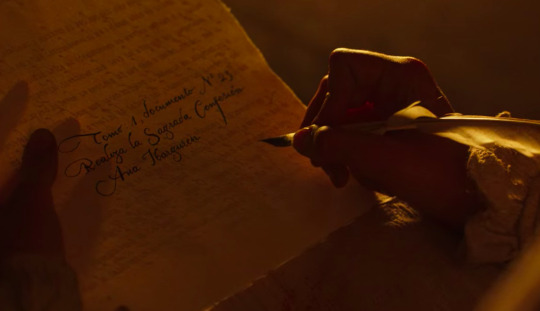
Akelarre pulled me in, ripped my heart out and put it back just to do it all over again. It is a story about six girls accused of witchcraft in 1609 and their bravery and cunning which they utilise to save themselves from being burned at the stake. But do they save their lives?
The film ends on a very literal cliffhanger - the girls, lead by Ana (Amaia Aberasturi) leap off a cliff into the ocean after being chased and surrounded by the Spanish royal guard.
I have so little words to say about this movie because nothing I write will have any chance of doing it justice. Never before have I been interested in films about witchcraft and the witch trials because they all seem too wrapped up in the mystical, spiritual darkness of it all to the point where most of the films forget the events happened. Real men and women were burned for their knowledge or physical appearance. What I equate Akelarre most to is Robert Egger’s 2015 film, ‘The VVitch”. With a 20 year gap of the period - Akelarre in 1609 and The VVitch in the 1630s - both still have very similar feelings about them. The camera direction, colour palette and tone are all so similar, but I think Akelarre deals with the events it portrays with far more empathy to the history.
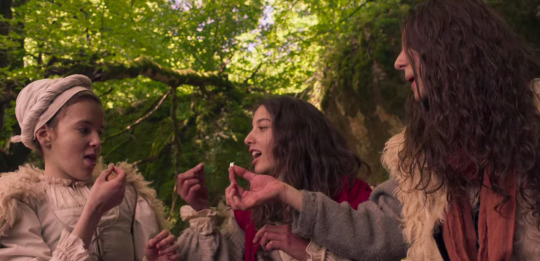
Specifically with this, I want to draw attention to the rituals displayed in both. The VVitch draws a lot of attention to Satan as ‘Black Philip’ and at the end of the film there is a supernatural bonfire scene wherein a group of naked women elevate into the air. I’m not here to say that scene, or, indeed the whole film, is bad, but it is a good starting point in the discussion for Akelarre’s ‘ritual scene’.
Akelarre tells and shows its ritual while Ana is being interrogated by the judge Rostegui (Alex Brendermuhl). Hoping to save her sister and her friends, Ana weavers a story made of truths of a happy memory and embellished lies to give Rostegui what he wants. And I think the description is my second favourite scene in this film. The audience gets to see the memory Ana is drawing her story from and hear the tale she is recounting to Rostegui at the same time. The audience hears her claim she turned her sister Maria (Yune Nogueiras) into a lamb which is shown as her putting on a lambskin jerkin. She claims to create illusions with smoke, which is shown as her and the rest of the girls sharing a pipe in a clearing. The very description she gives of Lucifer she takes from Rostegui himself, adoring the devil with the judge’s beard and light eyes. During the whole account I was enraptured as Rostegui himself.
Rostegui is so, pardon the pun, bewitched by Ana’s account that he has to see it for himself. He goes so far as to postpone the executions of the girls... until he is informed that the full moon when the girls want to ‘perform the ritual’ is the same day all their fathers and brothers get back from sea and might cause issues for the men. So Rostegui takes matters into his own hands and, using the descriptions told to him by Ana, tries to recreate the Sabbath ritual she was so detailed about. Rostegui is suffering both from the witch mania and his desire for Ana and this culminates in a scene that is nothing short of epic.
Personally, this is made all the better by not having a singe supernatural event occur. It felt more like a traditional pagan high-energy ritual than the supernatural, fantastical display in The VVitch. Everything is dark outside the circle created and inside is bathed in a heavy orange glow from the fire. Even thought the girls have been shackled by the guards for added protection, the magic is still there. And this is a magic that exists in our world as we know it. The girls feast and sing and dance. They create an infectious energy around them through nothing but their joy. This infects Rostegui to the point where the girls are even able to leave the fray they’ve created and escape.
This is the cliffside ending. The moon is full, the tide is meant to be high. The girls leap in the sea. Is the audience meant to hold out hope for them? Do the sailors save them? Do they die? My breath caught in my throat to witness it and it would not have had the same power if the ending was resolved.
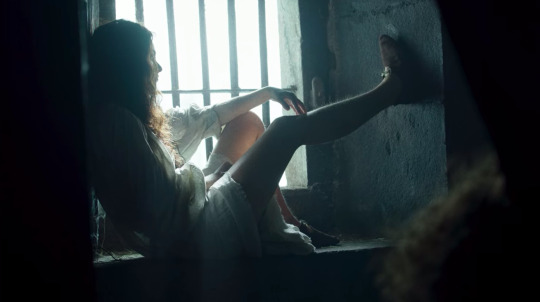
I am still in shock from this film. Everything from the plot to the characters to the costumes. And every frame looks like a Baroque painting. The play of texture, of light and shadow, of colour and absence... my jaw was on the floor the entire time. My notes for this post were so spares because I couldn’t bring myself to look away from the screen. Very few films in my life have had the power to so subtly wrap me in their world. One cannot sit with Akelarre without being transported to the universe it depicts. The screen is a thin veil of speration between the viewer and the characters. When the girls are tortured for information, their pain is tangible. When they run and leap and dance through the forest, sunlight and salt air plays on your skin just as much as it does theirs.
All of this is down to the sheer level of empathy to the plight of these women that I mentioned earlier. Perhaps it was a bit unfair comparing this period piece to a 2015 horror, but again, I also don’t think genre is a reason for a lack of empathy. This movie never made that mistake. Each actress was so chosen that they became the embodiment of all their character stood for. The gentleness of the acting and the masterful directing meant everything was played just enough for it to hit the audience in the gut like a freight train without allowing for any preparation. I am sure that this is a film which delivers some new, unique tidbit after each individual watch.

Akelarre is nothing short of a masterpiece that most certainly will have its place in the history of film for a long time coming. If not in all history, then at least in mine. As the credits rolled I had to forcibly crawl my way back to the real world and shake off the enchantment this left me with.
This will be one of my highest recommended films of all time: 9/10.
#akelarre#akelarre film#2020 movies#period drama#1600 movies#spanish movie#basque movie#pablo aguero#amaia aberasturi#alex brendermuhl#daniel fanego#garazi urkola#witch movies#coven#akelarre review#my review#full moon films#top films
27 notes
·
View notes
Text
The Covenant (2006)

Director: Renny Harlin
Writer: J. S. Cardone
Producers: Gary Lucchesi; Tom Rosenberg
Notable Cast: Steven Strait; Sebastian Stan; Laura Ramsey; Taylor Kitsch
Run Time: 97 minutes
Language: English
Restrictions: PG13 for violence, horror, language and nudity
Genre: Horror; Mystery; Thriller
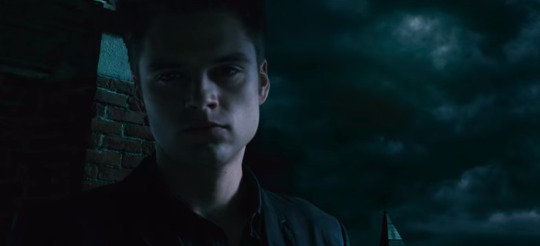
The Covenant is by far one of the worst films I have ever had the misfortune to see. But with Renny Harlin directing a typical early-2000s supernatural thriller film, it was never going to win any Oscars. Deemed a “Twilight for boys” it lives up to its title from everything to the constant turquoise filter (though, thankfully, not as saturated) to the unnatural line delivery.
The story, for all its messy plot dynamics, follows Caleb Danvers (Steven Strait) and his three witch friends Pogue (Taylor Kitsch), Reid (Toby Hemingway) and Tyler (Chace Crawford) as they all inch closer to the day where they turn 18, “Ascend” and inherit their full powers. If it were a more thought-out movie I’d say this sounds like an aggressive metaphor for adulthood, but in the way the movie plays out it is evident that this is far from the case.
Even though all the actors look blatantly as though they’re in their early to mid 20s, the boys are meant to be 17-year-old high schoolers and therefore act as such. They go to parties, they go out with girls and they like to cause destruction more than keeping their heads down and studying. The two girls in the film, Kate (Jessica Lucas) and Sarah (Laura Ramsey) are the same person with different hair colours. They hold no agency and exist to only entertain whichever of the “Sons of Ipswitch” - what Kate calls Caleb and his friends - wants them at that particular time. Sarah’s tattoos are more three-dimensional than she is.
And while the boys do get somewhat different personalities - Caleb the leader, Pogue the best friend, Reid the agitator and Tyler... Tyler could be written out and the movie would remain the same - their personalities aren’t static. Their core beliefs change whichever way the wind blows and the writing doesn’t know how to keep their voices consistent. With the literal silencing of Tyler, it is obvious the writers bit off more than they could chew. Even the film’s antagonist, Caleb’s mortal enemy Chase Collins (Sebastian Stan) takes a full 180 in his personality from the start to the climax for no reason. One minute he’s trying to get on Caleb’s good side and stab him in the back, and the next he’s loudly proclaiming his hatred by attacking everyone Caleb loves.
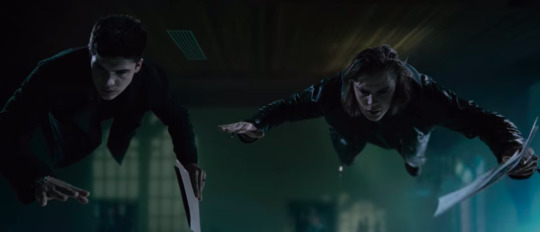
I use the word “loves” very freely because if there is one thing worse than the consistency of the characters themselves, it’s the chemistry of all interactions around each other.
Sarah, for all intents and purposes, is meant to serve as Caleb’s love interest. She’s the ray of sunshine that breaks through our hero’s cold outer shell. If only she was a ray of sunshine or Caleb had a cold outer shell. Every Interaction with them is drier than my grandmother’s pies and only served to lengthen an already threadbare script. After a week of knowing each other the audience is meant to believe that they are madly in love, but they can’t even be friends.
The other relationship in the film, that of Kate and Pogue, is better only in the sense that they’re meant to feel distant from one another. The writers gave up and wrote their lack of chemistry right in to the script it seems. At the end of the film when Kate is hospitalised due to Chase casting a spell on her - through some very confusing logic - only then does Pogue show any scrap of concern for her. Concern that is then overshadowed by the convoluted plot set in motion by Chase’s plans.
To be honest, the most organic interactions came about between Chase and Caleb, though that really isn’t saying much. In the first half of the movie, when the plot calls for Chase to be all puppies and rainbows, Caleb seems more invested in him than he does Sarah. He goes out of his way to spend time with Chase, even pushing back a dinner date with Sarah to later in the evening so they can spend the afternoon together. Their ‘warm up fight’ in Sarah’s bedroom in the second half of the film ends with the most heated, emotion fueled minutes of the boys cramped together on the bathroom floor. Chase goes so far as to kiss Caleb - after calling him “brother” to ease the tension of course - before storming out of the room. It can’t be good form for your protagonist and antagonist to have more emotion in their interactions than your protagonist and his compulsory love interest.
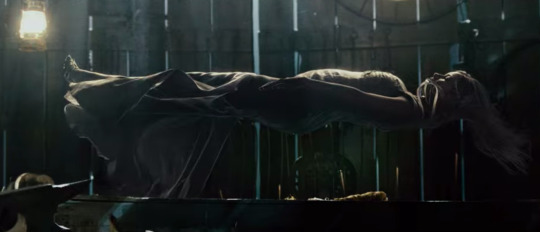
After watching this movie once, and then again, and then yet again, the plot still makes very little sense. The world and conflicts are introduced in a way that is cliche but understandable. The issue arises around Chase’s ideas for revenge.
Allegedly, he hates Caleb because their ancient relatives had bad blood. Chase being adopted, he only learned about this when he was a teenager and the Power that is so important to these Ipswitch witches had already taken over him. He moves to Caleb’s school after finding out who he is in an attempt to gather more Power and increase his strength. So far, the ambition makes sense.
What does not makes sense is his plan to take Caleb’s power.
Instead of focusing on the boy who he is quickly becoming close to, Chase targets everyone around him, drawing out the movie about 90 minutes longer than it needed to be. Chase’s logic follows that if he puts Kate in hospital, Pogue will come after her. At which point Chase can fight Pogue and hospitalise him, luring out Caleb. All of this he does, but then he goes to Sarah’s room, pretending to be Caleb. Even though all these boys look identical he still thinks it necessary to glamour himself. Now placing a spell on Sarah, Caleb comes to the room to find them both. Which results in their warm-up fight and Chase begging for Caleb’s Power.
I honestly see no reason why all three middle men couldn’t have been cut out. At least Kate and Pogue, there is no reason that they should have been involved under that justification. Sarah is the only “bait” I can suspend my disbelief for.
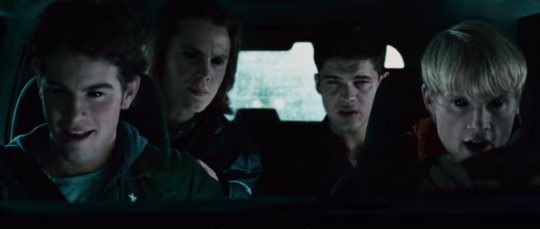
This film is such a disaster that there is nothing more to add.
Except - I enjoyed it. It’s one of the worst films I will ever watch and now it’s also one of my favourites. The plot is a wreck. The acting would have more expression if done by sock puppets. The dialogue choices are questionable at best (featuring among their greatest hits the iconic “Harry Potter can kiss my ass” and “Wiatch”) but that adds to the enjoyment of it all. It’s a movie to watch when you don’t need to think and can watch someone else’s failure to feel better about yourself. Because if someone can get funding and cinema screening for this 3/10 movie, anything is possible.
#the covenant#the covenant movie#2006 movies#the covenant review#full moon films#renny harlin#steven strait#sebastian stan#laura ramsey#taylor kitsch#horror movies#horror#mystery#thriller#bad movies
14 notes
·
View notes
Text
The Water Man (2020)

Director: David Oyelowo
Writer: Emma Needell
Producers: David Oyelowo; Carla Gardini; Shivani Rawat; Monica Levinson
Notable Cast: David Oyelowo; Rosario Dawson; Lonnie Chavis; Amiah Miller
Run Time: 92 minutes
Language: English
Restrictions: PG for language and horror
Genre: Adventure; Drama

The Water Man. Where to even begin with this beautiful gem of a film?
The story follows eleven-year old Gunner Boone (Lonnie Chavis) a he navigates the new emotional storm he finds himself in following the move to a new town on top of his mother’s leukemia diagnosis. Spurred on by his imaginative mind and his bottomless wells of hope, Gunner becomes intrigued with the story of the Water Man, a seemingly immortal man who can bring those lost back from the dead. Along the way he teams up with headstrong Jo Riley (Amiah Miller) and learns the meaning of family bonds, love and death.
As the story is so emotional, it relies heavily on colour, frame composition and camera angles to help tell more to the story than what is just expressed through dialogue or action. The four main characters - Gunner, Jo, Amos Boone (David Oyelowo) and Mary Boone (Rosario Dawson) - express emotion and steps in life’s journey just as much as they are their own characters. To add to the brilliance of the multiple narrative techniques, this story is first and foremost a family film. The main characters are preteens and act as such. But this doesn’t mean the film shies away from its big topics. Instead it handles them with compassion in a way that is understandable to the younger target audience, but also recognises their intelligence and speaks on their level, through characters they can relate to or desire to imprint on.
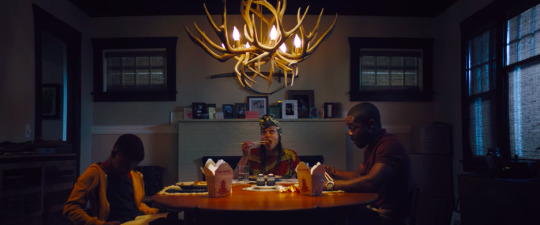
Right away, the most obvious thing about this movie’s storytelling is its use of colour, focusing primarily on yellow, blue and, to an extent, red.
Yellow is in almost every scene, and the audience does not see Gunner without the colour yellow being somewhere in the frame. From his bedroom walls to his favourite jacket and even the graffiti which he chooses to leave his scooter parked against, yellow is everywhere in Gunner’s world. This could be read as his joy and wide-eyed innocence to the world. He’s a child and no hardship has befallen him yet. Once he discovers and understands the extent of his mother’s illness, however, he still maintains this yellow. Here it could be symbolic of hope - a theme that becomes prevalent through the movie - and a way for Gunner to hold on to those feelings of joy he associates strongly with his mother and his family. Yellow to him represents how he sees his family. They’re alive, they’re warm and they’re joyous. Later, the stone the Water Man uses to revive the dead is, in Gunner’s imagination, yellow, Here again the colour is shown to be one of hope. His journey throughout the story is spurred on by this beacon of warm yellow.
Red is Amos’s colour. Still warm, it is darker than the bright, young optimism of his son. Amos was in the navy and has lived long enough to see the good and bad of humanity. He is also far more aware of the extent of his wife’s leukemia than his son is, hoping to protect him by maintaining his ignorance of the situation. Red is also a colour of power, something that Amos, as the perceived head of his family, tries to show people he has even if he himself doesn’t believe it. This show of power goes so far as him owning a bright red pickup truck, a vehicle which gets him through a literal police road block during the film’s climax in an effort to save his son.
Mary combines both of these. When she is first shown on screen, she is wearing bright patterns in red and yellow. She is the glue that connects the family together so that Amos has something to protect and Gunner has something to find joy in. At the start of the movie, Gunner and Amos’s relationship is terse, due to Amos’s absence while being stationed in the navy in Japan. They cannot connect to each other and it is up to Mary to be the connection for them. But as Mary gets more sick her clothes loose their bright, bold statements and as they do, Amos and Gunner become closer. Amos learns to connect to his emotions and show his son love. Gunner learns that he can rely on his father and he doesn’t need to put the weight of his mother’s illness on his shoulders.
Finally there is the blue, brought through the film through cynical Jo. Blue is far colder than yellow or red and Jo, too, doesn’t believe she needs anyone to look out for her. She also wears red initially to show power where she doesn’t have any, much like Amos. But as the film progresses all her red falls away and only the blue remains. While her and Gunner are in the forest alone, moving further from their homes, Jo lets herself feel more and more vulnerable, showing off her soft, true, blue side and not her fiery red facade. Her blue coding shows how isolated she is and how desperate she feels she needs to be loved by someone. Gunner in his bright innocence shows her she doesn’t have to be cold and aloof to protect herself. In a final scene she is sitting at the dinner table with Gunner and his parents, wearing a yellow shirt. She may be older than Gunner, but he teaches her lessons in kindness, openness and community.

The camera, too, is a voice just as strong as the voice of colour. The shots pay close attention to the dominant emotions of the characters in their situations and act accordingly.
When his parents find out that the graphic novel Gunner is writing centres itself around death, they move to a sheltered corridor to talk about it. The whole scene is filmed behind Gunner’s partially-open door. The audience is made aware of how private the moment is and the isolation of Gunner from the situation. When Mary is too sick to get out of bed and a home nurse staff comes to install medical machines to monitor her vitals, it all happens in the cut-off view Gunner has of it all through the door as he stands in the corridor. He does not understand his mother’s disease and his parents won’t help him to understand. The only way he knows anything about leukemia is through books he borrows from his favourite town bookstore - the same way he stumbles upon the ‘reality’ of the Water Man.
The camera is also the voice that reminds the audience how small Gunner is when he and Jo embark on their journey to find the elusive Water Man and find a permanent cure for Mary. Every introductory shot of them is far away, leaving them as two tiny yellow and blue specks in the vast, overwhelming landscape. It solidifies how out of their depth the children are, even if their young bravery won’t let them see that. The opening shot of the film is an aerial view of Gunner riding a scooter through a cemetery. Death is all around him, and he feels so small in the face of it.
When something confusing happens in the story or there is a cause for Gunner to be disoriented, the camera tracks a circle around him. When he and Jo come across a patch of falling ‘snow’ (actually ash from a current forest fire), Gunner and the camera dance around in it as upbeat music plays under him. He doesn’t know why there is snow, but his hopeful, yellow personality tells him it must be good. But when he hears strange noises in the forest at night and goes to investigate, the camera here too circles him. But now it is not a sign of wonder in the face of the unknown, but rather an isolating confusion. Gunner takes centre frame as a light against pitch black. Fear disorients him and his hope and all of this is told through the track of a camera.

The Water Man ends up being nothing but a ghost story that Gunner in his innocent hope wants to believe. But that doesn’t mean that the film is void of any lessons, especially lessons important for any child to come to terms with.
I could’t help but notice the Boone family being the only three black people in the whole town of Pine Mills. This, the fact that they only recently moved in and Mary being sick should make them the most ‘othered’ members of the tiny community. Amos drives through the town and the movie pointedly stops to look at the older, white residents and Amos’s uncertainty over it. But apart from that this ‘othering’ is little discussed. The movie is through Gunner’s perspective and it seems that he has been taught how to be more friendly, polite and well-spoken than most of the adults to overcome this. People are drawn to Gunner and everyone - even the sheriff who only knows him from his missing poster - warms up to him. Even though the story is told through him, he seems like an attainable goal. His character is presented as the good one. The peace-loving, book-reading, well dressed, open young boy. He leaves without his parents’ permission to a place they don’t know, but texts his mom to save her from worrying. He doesn’t retaliate when Jo lashes out at him. He is friendly to the owner of the bookstore. He is ready to listen to the town’s designated ‘crazy scientist’ (who is played by Alfred Molina, which I find amusing) with a sympathetic ear and a curious mind. His character prioritises love over any show of masculine strength. And this character embodied by a young, black boy is a message that needs to be heard loud and clear across the board.
On the other hand, Jo is the cynical opposite and the other character children watching this movie would relate to. She is the ‘cool girl’ with blue hair, strong eyeliner and mystic tales of her brush with death at the hands of the Water Man. But this is quickly shown as a negative character through the responses of Gunner. Though calm and gentle, he condemns Jo’s thievery, her aggression and her need to be flawless in everything. Instead of taking a joke, she retreats in to herself. She acts brave, but, unlike Gunner, she is running away from and not towards something. Her character would rather escape than face her issues - those issues bing the very real problem of an abusive, negligent father. Gunner is the first person to show her genuine love and at first it scares her. She pushes him away when she feels her guard coming down. But what starts in a bright red tent as a way for her to lord power over a younger boy, grows into a genuine friendship by the end of it. At every day in their journey they get closer. From sleeping at different times to sleeping on opposite sides of a literal line in the sand to a final hug as Gunner saves Jo from the flames, her redemption shows that, while your past is a part of you, it need not define your character.
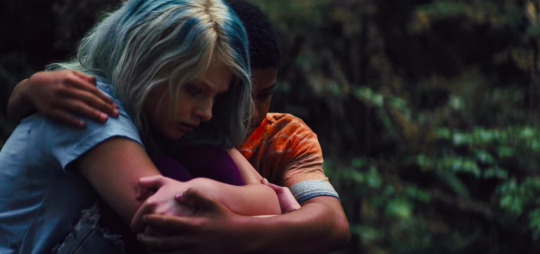
Another massive part of the story is the complicated relationship between father and son. Mary and Gunner get on together easily and have a natural read on each other. But between Gunner and Amos, things are more strained. Amos doesn’t know how to talk to Gunner at the start of the film. He tries to play football with his sensitive, creative son, destroying his graphic novel in the process. He can’t handle any difficult conversations with Gunner, especially not those which discuss Mary and her illness.
But it is Amos who leaves everything to look for and save his son once he goes missing. It is Amos who Gunner trusts enough to let him be carried across a lake - his greatest fear is water. It is also Amos at the end of the film that buys Gunner new art supplies and encourages him to work through his creative block. After they come home, Gunner is dressed in a red shirt, a colour related to Amos, and Amos is in yellow. Amos, too, confronts Gunner about death, specifically Mary’s. They all know what will happen, and while Mary laughs it off, saying after death she’ll go to “The Cheesecake Factory”, Amos sympathises with Gunner. He admits he hates the idea of losing Mary and it is this act of vulnerability that eventually leads to Gunner and Amos sharing their first hug.

The Water Man handles the topics of life, death, love and sickness with amazing poise for a film targeted at such a young demographic. But this limited age does mean that some parts added to the film undermine its message.
There are a few moments with too much whimsey. Yes, Gunner is creative and when this is expressed through his drawings being animated in his sketchbook, or an animation of the history of the Water Man, it works. But when it is used to create a tsunami of bugs washing Jo and Gunner away from their supplies in the middle of the night, it goes a little too far. Gunner imagining his whole encounter with the Water Man himself also feels a little too much like the cliche “and it was all a dream” sequence everyone knows and hates.
The subplot of the forest fire also doesn’t lead anywhere. There is no real emphasis placed on the opposites of fire and water. Apart from speeding up the events of the film and creating higher stakes for Amos to find his son, it amounts to next to nothing. It felt like filler in a script that was so rich otherwise it didn’t need it in the first place.
But it still stands as one of the best family films I have seen. Perhaps even one of the most eloquent films I have seen and I believe it deserves a full 8/10 final score.
#the water man#the water man review#2020 movies#adventure#drama#david oyelowo#rasario dawson#lonnie chavis#amiach miller#movie review#my review#my thoughts
3 notes
·
View notes
Text
He Never Died (2015)
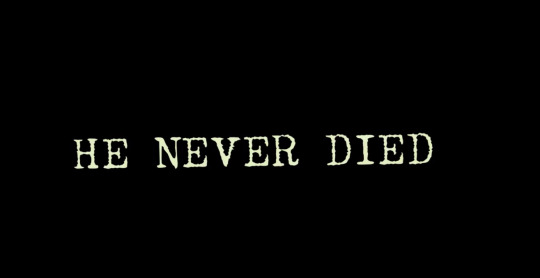
Director: Jason Krawczyk
Writer: Jason Krawczyk
Producers: Zach Hagen; Adrienne Stern
Notable Cast: Henry Rollins; Booboo Stewart; Steven Ogg; Jordan Todosey
Run Time: 99 minutes
Language: English
Restrictions: 18 for violence and language
Genres: Horror; Thriller; Comedy
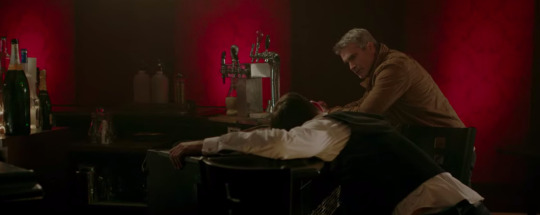
He Never Died is a black comedy film that documents the events of reclusive, stoic Jack (Henry Rollins) after his estranged daughter Andrea (Jordan Todosey) finds her way in to his life. Throughout the course of the film we come to see the plainness of Jack’s life offset by the outgoing, party spirit of Andrea and the high-octane, violent life of the gang bent on capturing him. Throughout it all Jack tries to maintain his fragile grasp on his normalcy, quietly picking himself back up after every pitfall.
When we first see Jack he’s asleep in his apartment, plagued by the sounds of war and destruction from times gone by. And it’s only after he takes part in one of his thrice-weekly bingo sessions do these noises fall away and leave him with what the audience starkly sees as blissful peace following the audio aftermath. This is something that becomes a theme in the film. Violence is alluded to - through its consequence, through shadows, through objective commentary - more than it is actually shown. As the film progresses and we discover that Jack is in fact the biblical Cain and has seen millennia of violence that he believes he is the root cause of, it is easy to understand why this would be. Jack wants to distance himself from all this pain as much as he can. And since we as the audience experience the world through Jack, we, too, are separate from the violence to a degree.
Unfortunately, this separation does not extend to the rest of the sympathetic characters, with all of them being either physically or emotionally hurt. Jeremy (Booboo Stewart) is Jack’s intern for a job that pays well but which we know nothing about. He is the first character to feel the damage that association with Jack causes, being tortured by the gang with a vendetta against Jack and spending almost the entirety of the movie off-screen and in a hospital. Gillian, Jack’s ex-wife and Andrea’s mother, is never shown on screen, but after the gang kidnaps Andrea in an attempt to bait Jack, she is murdered. Again, this act is said, but never shown. At the end of the film when Andrea is rescued, she is bruised and bleeding and in need of urgent medical care, but we don’t see her being tortured. Cara (Kate Greenhouse), a waitress at the diner Jack frequents is subject to intense trauma after seeing the violence that Jack is so separate from.
I think this factor of the film is an interesting play on the concept of “show don’t tell”. It is completely reversed and adds to the character of Jack as distant, almost emotionless and stoic. If every violent scene was played in full, the movie would run the risk of being a testosterone-fueled action flick; something that, in my opinion, the tone does not support.
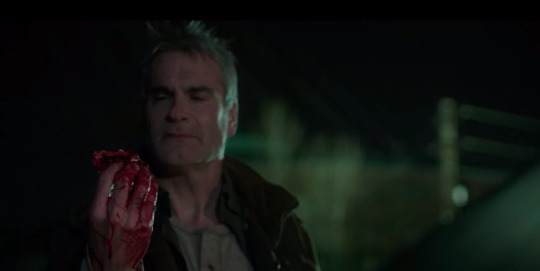
He Never Died seems to be as much a story about addiction as it is about fatherhood and family. Right from the start, Jack is shown to be the antithesis of a ‘people person’, doing the bare minimum in this modern world in the way of paying rent, going for walks and frequenting a diner, but he is a man of few words and fewer facial expressions.
Andrea is everything Jack is not. From her youth to her clothes to her loud, rambunctious, devil-may-care attitude, she acts as a way for the audience both to get to know Jack more and for Jack to see himself in someone else. Just like Jack, Andrea has an addictive personality. The difference being her poison comes in the form of alcohol and Adderall, not human flesh. Both toe the line of sobriety and both break it. Andrea gets drunk and Jack looks after her - begrudgingly - until she sobers up. Jack’s drink at the diner gets spiked and after his own abduction by the gang he lapses into cannibalism to satiate himself. But while he feels stronger, he turns on his family. No longer the one to protect Andrea, it is not long before she falls in to the gang’s grasp.
This vendetta against Jack is one of the two sides of family the film deals with. The gang is run by Alex (Steven Ogg), the son of the man that Jack used to be employed by as a bodyguard - an invincibility to everything does make for some excellent security. In a final monologue after a relatively non-violent fight, it is revealed that Jack killed Alex’s father and Alex is bent on revenge. Alex wants Jack dead for killing his father and Jack wants Alex dead for hurting his daughter and Jeremy, who can be seen as Jack’s surrogate son. In the end, Jack doesn’t kill Alex, but instead takes Andrea to the hospital. This marks him trying again to control his addictions. But instead of being reclusive like he has in the past, he is now doing it by connecting with Andrea and, to an extent, Cara.

Most stories follow the turning points of the well-known hero’s journey, and this is no different. Even if the ‘hero’ is the creator of the original sin.
In the biblical story of Cain, he kills his brother through a jealous rage brought on by feelings of being inadequate. He is punished for this murder and for bringing all murder in to the world by being forced to walk the earth for eternity. In one of the first shots of the film, the audience is shown two deep scars on Jack’s back, in the place wings might have been. But there is no reference to Cain ever being angelic, or demonic for that matter, so it is also possible that these scars are in some way a reference to the ‘Mark of Cain’. Regardless, they don’t seem to have any role in the film, besides being the only wounds he ever has. He gets shot multiple times throughout the film and by eating is completely healed, so even if the scars are not brought up, there is no doubt they hold some greater significance, be that biblical, historical or simply something in Jack’s life.
Adding on to the idea of eating and healing, food seems to hold a certain amount of weight in the film. One of the only places Jack visits is a diner, going there every day for years. When he visits the diner the day after meeting Andrea, she makes a fuss about him being vegetarian after he orders an eggplant, claiming he looks like someone who eats a lot of meat. Later in the film, back at the diner after Andrea’s kidnapping, he orders a rare steak. The more wounded he becomes, the more flesh he consumes, eating the fingers off one of the gang members to heal his head after multiple gunshot wounds. He is immortal, but he still needs to heal. If the idea of his cannibalism being an addiction is to carry through, this could be cause for some concerning implications. While the reason something is addictive is because it makes the user feel good, flesh literally heals Jack. But the film also shows the other more sinister side to this. The more flesh Jack consumes, the more violent he becomes. The more violent he becomes, the more he needs to heal. The more he needs to heal, the more flesh he needs to consume. And on and on until he finds something bigger than this addiction. In the case of the film, that something is the eventual connections with Cara and Andrea.
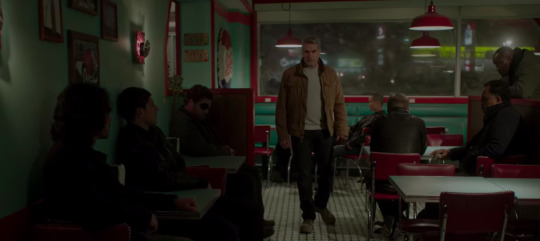
While this is a violent thriller first and foremost, the dry, dark humour is not lost. Admittedly, Rollins’ deadpan line delivery took me a third of the movie to warm up to, but once I did nearly every other line had some form of flat humour written in to it. Most notably I think is a line spoken after Andrea’s kidnapping. In an effort to distance himself from it, Jack attempts to continue life as normal. He goes to the diner. He goes on walks. He sleeps in his apartment. While walking Cara to her apartment, the question of Andrea’s whereabouts comes up. Knowing the gravity of the situation, Jack responds to Cara’s question with:
“She’s probably with her mother at this point.”
Which leads to a question about divorced parents and no follow up on how certain Jack is that Andrea is dead. Because, of course, Cara has no idea.
After being maced during an attempted interrogation from these, frankly, unintimidating gang thugs, Jack goes to the diner where Cara instantly notices the damage. As he is still on his vegetarian diet, he isn’t healing too quickly and blames the mace burns on his landlady.
“Isn’t your landlord like... 90 years old?” Cara asks.
“Yeah.” Jack replies, “But she’s spry.”
And the deadpan, dry delivery makes the one-liners far more funny than if they were animated or had any other form of attention drawn to them. They kept the pacing of the story flowing from scene to scene, diner to bingo to apartment. And throughout it all the sense that Jack has seen everything and done everything is always alluded to in both his tone and his dialogue. Jack is tired. He literally spends the vast majority of his time asleep and has notably less energy than everyone he interacts with, including spry old landlady Ruth. He talks little because to him there is nothing new to say. He follows the same routine because there is nothing new to do. He is jaded from the world and his character reflects that brilliantly. And through it all he still finds a way to learn to care for Andrea, the daughter he never knew he had or wanted.

He Never Died is the movie I didn’t know I wanted to see. The title is terrible, the introduction meant I didn’t warm up to the film as quickly as I could have. Overall, for a film rated so high for violence, it is extremely lackluster.
But there is still something about it that made me stay to the end. The characters are organic and loveable, everyone from sour Jack to bright Andrea, practical Cara to obnoxious Alex. Everyone has their own part to play.
However, throughout the film a shadowy figure with a hat and a goatee follows Jack around. He is the only person who is seemingly stronger than Jack and only he and Andrea can see him. When the man appears, Jack cannot kill his intended victim, and Jack treats him like the enemy. But we get no clarification on who this man is in the movie or what his greater role is. It is shown that he isn’t God as Jack curses her out for allowing this man to be a part of his punishment, too. It left the film on a cliffhanger, but with not enough clues to the role he plays, it’s not a cliffhanger that will stay with me.
I think, all things considered, this movie has earned a fair score of 6/10.
#he never died#review#film review#movie#henry rollins#booboo stewart#steven ogg#jordan todosey#jason kraweczyk#2015 movies#full moon films#horror#black comedy#thriller#english movies#mark of cain#cain#vampire
8 notes
·
View notes